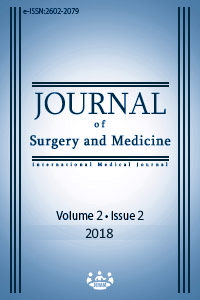Evaluation of Lichtenstein and posterior wall darn techniques in inguinal hernia surgery: A prospective cohort study
Keywords:
Inguinal hernia, Lichtenstein repair, Posterior wall darn repairAbstract
Aim: Inguinal hernia repair is the most common surgical operation in the world. Although the inguinal hernia is as frequent as 75% of all hernias and 3.8% of the whole population, the best form of repair has not yet become clear. The purpose of the hernia repair is simple, easy to apply, safe operation which requires minimal dissection and sufficient exploration, early patient care, reduction of operation cost, loss of labor force, hospital stay and return to work, and minimizing recurrences. Our aim in this study is to compare Lichtenstein tension free technique and posterior wall darn repair (Moloney) techniques.
Methods: This study was designed as a prospective study and was performed in patients who underwent surgery for inguinal hernia in the General Surgery Clinic of Istanbul Training and Research Hospital. A total of 100 patients were divided into two groups (50 posterior wall darn repair, 50 Lichtenstein repair). All patients were hospitalized and their time to return to work was recorded. Patients were called to the controls and checked for recurrence. Criteria such as postoperative patient comfort, complications, active life start time and recurrence were evaluated. The groups were compared statistically.
Results: In our study, there was no significant difference between the two groups in terms of return to work, mobilization and recurrence (p>0.05). Lichtenstein technique was applied statistically in terms of hospitalization time, complication and duration of operation compared to the other groups (p<0.05).
Conclusion: We favor Lichtenstein technique in the treatment of inguinal hernia because of the short duration of operation, short hospitalization time and low complication rate compared with posterior wall darn technique, with similar recurrence rates in both groups.
Downloads
References
Kingsnort AN, Gray MR, Nott DM. Prospective randomized trial comparing the Shouldice technique and plication darn for inguinal hernia. Br J Sur 1992;79:1068-70.
Çalışkan YK. Ten years ago, what was the main etiology of intestinal obstructions? Historical perspective: A retrospective cohort study. J Surg Med. 2017;1(2):21-3.
Acehan T, Köse E, Gündüz İ, Sağlam F. De Garengeot hernisinin perfore apendisit ile birlikteliği: Nadir bir olgu sunumu. Arch Clin Exp Med. 2017;2(1):24-5.
Read RC. Historical Survey of the Treatment of Hernia. In Nyhus LM editor. Hernia. 3 rd ed. Philadelphia: Lippincott Company, 1989, 1-12.
Atasoy G,Temiz A, Albayrak Y, Yalcin A. A rare case of left paraduodenal hernia: A case report. Arch Clin Exp Med. 2017;2(2):55-7.
Lee SD, Son T, Lee JB, Chang YS. Comparison of partially-absorbable lightweight mesh with heavyweight mesh for inguinal hernia repair: multicenter randomized study. Ann Surg Treat Res. 2017;93:322-30.
Çolak T, Ertürk C. İki taraflı kasık fıtıklarının polipropilen mesh ile eş zamanlı açık onarımı. Klinik ve Deneysel Cerrahi 2000;8:31-35.
Subasi IE, Yucel M, Hasbahceci M, Basak F, Alimoglu O. Day-case surgery for inguinal hernia: Lichtenstein inguinal hernia repair under local anesthesia performed by surgical residents. Arch Clin Exp Med. 2016;1(1):4-7. 9. Saygun O, Özlem N, Erdoğan B. İndirekt inguinal hernilerin sütürsüz onarımı. GATA Bülteni. 1998;40:22-28.
Kark AE, Kurzer M, Waters KJ. Tension-Free mesh hernia repair. Review of 1098 cases using local anaesthesia in day unit, Ann R Coll Surg Engl. 1995;77:299-304.
Bellone D, Sacco D, Spidalieri G, Cardiono L. Tension-free hernioplasty. Minerva Chir. 1999;54:123-5.
McGillicudy JE. Prospective randomized comparison of the Shouldice and Lichtenstein Tension Free hernia repair procedures. Arch Surg. 1998;133:974.
Soybir G, Aker Y, Köksoy F. Primer inguinal fıtıklarda rutin poliprolen greft kullanımı, Ulusal Cerrahi Dergisi. 1992; 8:118-21.
Amid G.E, Shulman A.G, Lichtenstein I.L. Open tension-free repair of inguinal hernias, the Lichtenstein tension free technique. Eur J Surg. 1996;162:447-53.
Bay-Nielsen M, Nordin P, Nilsson E, Kehlet H. Operative findings in recurrent hernia after a Lichtenstein procedure. Am J Surg. 2001;182:134-6.
Velitchkov NG, Losanoff JE, Kjossev KT, Grigorov GI, Kirov GK, Losanoff CE The Lichtenstein open tension free inguinal hernia repair using a new prosthetic mesh Bulgarian irresorbable ampoxen. Int Surg. 1996;81:205-9.
Nielsen MB, Kehlet H, Strand L, Malmstrom J, Andersen FH, Wara P, Juul P, Callesen T. Quality assessment of 26304 herniorrhaphies in Denmark; A prospective nationwide study. Lancet. 2001;358:1124-8.
Voyles CR, Hamilton BJ, Johnson WD, Kano N. Meta-analysis of laparoscopic inguinal hernia trials favors open hernia repair with preperitoneal mesh prosthesis. Am J Surg. 2002;184:6-10.
Eryılmaz R, Şahin M, Akdağ M. İnguinal hemi onarımından sonra kronik inguinal ağrı. Çağdaş Cerrahi Dergisi. 2003;17:104–8.
Koukourou A, Lyon W, Rice J, Wattchow DA. Prospective randomized trial of polypropylene mesh compared with nylon darn in inguinal hernia repair. Br J Surg. 2001;88:931-4.
Amid G.E, Shulman A.G, Lichtenstein I.L. Simultaneous repair of bilateral inguinal hernias under local anesthesia. Ann of Surg. 1996;223:249-52.
Çolak T, Ertürk C. İki taraflı kasık fıtıklarının polipropilen mesh ile eş zamanlı açık onarımı. Klinik ve Deneysel Cerrahi. 2000;8:31-5.
Kark A.E, Kurzer M, Waters K.J. Tension-Free mesh hernia repair. Review of 1098 cases using local anaesthesia in day unit, Ann R Coll Surg Engl. 1995;77:299-304.
Palumbo P, Pulcini M, Turano R. Local anaesthesia in the surgery of inguinal hernia. Minerva Chirg. 1997;52:509-12.
Downloads
- 2862 2634
Published
Issue
Section
How to Cite
License
Copyright (c) 2018 Yahya Kemal Çalışkan, Celal Özkarabulut, Arslan Kaygusuz
This work is licensed under a Creative Commons Attribution-NonCommercial-NoDerivatives 4.0 International License.















